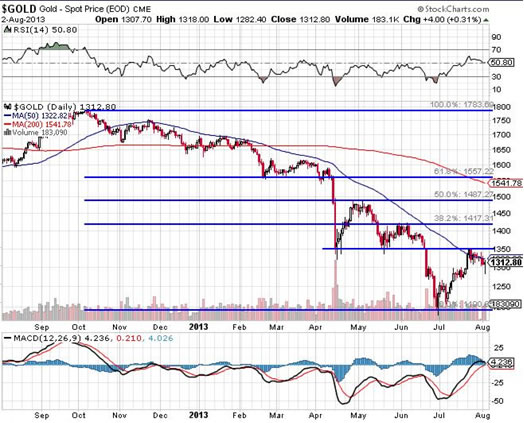When Gold Bullion Prices Will Rebound
Commodities / Gold and Silver 2013 Aug 07, 2013 - 01:54 PM GMTSasha Cekerevac writes: A common question that I receive from readers is in regard to gold bullion. Many people over the past few years have begun allocating a portion of their investment strategy into the yellow precious metal and are curious about what’s possible in the near future.
Naturally, with gold prices down over 20% this year, this has certainly hurt investors. The questions many are asking are: what will be the catalyst for a boost in gold prices and when will they rebound?
As I’ve discussed many times over the past few months, most of the selling in gold bullion has been through large institutions. These funds have been reallocating their investment strategy to incorporate a different landscape than what we’ve seen over the past few years.
While retail demand for physical gold has remained strong, there still remains far more supply than demand, as can be seen by the relatively depressed price. What is occurring that should help gold bullion prices is that most mining companies are curtailing their production of gold bullion.
Over the past couple of months, gold miners have written off over $20.0 billion in assets, which have become uneconomic due to the high costs of extraction and low price of gold bullion.
If demand remains stable, the eventual supply reduction should help gold prices. The investment strategy by these mining companies is completely appropriate, since one should not be producing at a higher cost than what is available on the open market.
I think we will continue to see many gold bullion producers close mines that have all-in costs in excess of $1,100 per ounce. Anything higher and that leaves an extremely small margin in relation to the current price of gold. The ultimate investment strategy for a company should be maximizing profitability, not simply producing gold bullion at any cost, which will eventually result in losses as costs continue to escalate while commodity market prices plummet.

Chart courtesy of www.StockCharts.com
The selling pressure for gold bullion began to reduce in intensity in the beginning of July, because large institutions have essentially reallocated their investment strategy out of gold. At the same time, we saw demand finally overcome supply and move gold bullion up to the $1,350 area, meaning what had been the support level was then the resistance. Investors in exchange-traded funds (ETFs) have dumped in excess of 600 tons of gold bullion so far this year.
As I wrote last month in the article “Investing in Gold Bullion Is All About Timing—Here’s How to Do It Right,” when gold bullion was trading at $1,240, it appears the risk-to-reward scenario was quite favorable, with the thought that gold bullion could move up to the $1,400–$1,500 area.
If gold bullion miners continue to shift their investment strategy into lower-cost assets, reducing total supply produced, and if physical demand remains strong, we should eventually see a positive push in gold prices.
As an example of supply and demand in action, take a look at the platinum and palladium markets. While gold bullion is down over 20%, platinum is only down approximately six percent and palladium is up five percent year-to-date. This is because both platinum and palladium will, in my opinion, see a deficit in supply this year and most likely next year. Economic demand is improving, creating industrial demand that is greater than the supply, since production is constrained due to serious labor issues in South Africa.
Over the long term, it is beneficial for gold prices if supply is reduced to meet demand and not exceed it. While this shift in investment strategy has hurt investors in gold mining stocks, writing off assets that were overpaid and underperforming does make financial sense. After all, investors don’t benefit if it costs the company more money to produce a commodity than what the firm can get on the open market.
This article When Gold Bullion Prices Will Rebound was originally published at Investment Contrarians
By George Leong, BA, B. Comm.
www.investmentcontrarians.com
Investment Contrarians is our daily financial e-letter dedicated to helping investors make money by going against the “herd mentality.”
George Leong, B. Comm. is a Senior Editor at Lombardi Financial, and has been involved in analyzing the stock markets for two decades where he employs both fundamental and technical analysis. His overall market timing and trading knowledge is extensive in the areas of small-cap research and option trading. George is the editor of several of Lombardi’s popular financial newsletters, including The China Letter, Special Situations, and Obscene Profits, among others. He has written technical and fundamental columns for numerous stock market news web sites, and he is the author of Quick Wealth Options Strategy and Mastering 7 Proven Options Strategies. Prior to starting with Lombardi Financial, George was employed as a financial analyst with Globe Information Services. See George Leong Article Archives
Copyright © 2013 Investment Contrarians- All Rights Reserved Disclaimer: The above is a matter of opinion provided for general information purposes only and is not intended as investment advice. Information and analysis above are derived from sources and utilising methods believed to be reliable, but we cannot accept responsibility for any losses you may incur as a result of this analysis. Individuals should consult with their personal financial advisors.
Investment Contrarians Archive |
© 2005-2022 http://www.MarketOracle.co.uk - The Market Oracle is a FREE Daily Financial Markets Analysis & Forecasting online publication.



